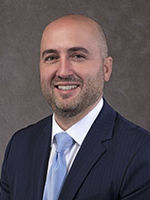
Welcome!
The Entry-Level Bachelor of Science in Radiation Sciences (EL BSRS) is a full-time, 3-year program that includes online and on-campus classes. This program is designed to provide students with a pathway to satisfy educational requirements and apply for the ARRT credential in Radiography. Didactic classes are offered on-campus and online, either synchronously or asynchronously. Clinical classes are offered in-person at one of the approved clinical education locations. Additionally, this program offers students opportunities to prepare for advanced specialty areas such as Cardiac Interventional Radiography (CI), Computed Tomography (CT), Magnetic Resonance Imaging (MRI), Mammography (M), Vascular Interventional Radiography (VI), and education and management. This program incorporates on campus, online, and hybrid instructional methodologies.
About The Profession
Radiographers are essential to modern healthcare, working across hospitals, clinics, and specialized imaging centers to produce critical diagnostic images. With strong demand for radiologic technologists, this field offers stability, diverse career settings, and paths for advancement through additional certifications and skills.
Register for an Information Session Apply Now
Why Choose LLU's Radiation Sciences Bachelor's Program?
- Advanced Specialty Courses: The EL BSRS program offers students opportunities to prepare for advanced specialty areas such as Cardiac Interventional Radiography (CI), Computed Tomography (CT), Magnetic Resonance Imaging (MRI), Mammography (M), Vascular Interventional Radiography (VI), and education and management, which can create opportunities for students to earn additional certifications and broaden career opportunities.
- Decades of Expertise: With the professional faculty and low student-to-faculty ratio, the EL BSRS program combines the highest-quality academic training with hands-on clinical experience with opportunities to train at Loma Linda University Health’s nationally-ranked level 1 trauma center to prepare students thoroughly for the ARRT board exam and beyond.
The Loma Linda Difference

Our institution stands out from the rest with our commitment to Whole Person Care. You will join a community that values excellence, compassion, and holistic education by learning to look beyond numbers and diseases, and incorporates compassionate mental and spiritual health into patient care. Just a few of the other reasons our institution's educational experience is exceptional and unique include:
- Service Learning included in the EL BSRS program. Each student will complete service learning during the program. The motto of the School of Allied Health Professions is "To Lead, To Heal, To Service," and service learning is an essential component of the curriculum. Students have opportunities to serve locally and internationally.
- Interprofessional education focuses on collaboration. ELBSRS students attend an interprofessional lab where they roll-play scenarios with medical, dental, nursing, pharmacy, behavioral health, and allied health students in order to grow in their ability to work on the health care team.
Program Overview
Admissions Requirements
How to Begin:
Applications are accepted between October 1st and February 15th. There is no waiting list. Up to 25 seats are available for each cohort. The fee for applying is $60. To have the application fee waived, attend a free online information session or attend the annual Loma Linda University Open House in January. Please review the steps to admission:
- Step 1: Attend a free online information session. This is recommended for all applicants and is an opportunity to virtually meet with our faculty to learn more about our program and ask questions.
- Step 2: Start the application process. Please note that you must be a citizen or permanent resident of the U.S. to be eligible for this particular program. For more information, please visit International Student & Scholar Services.
- Step 4: Schedule the career observation. Contact Christian Roath, Clinical Coordinator, at [email protected] to schedule the career observation or to discuss ARRT ethics issues. Download the career observation form.
- Step 5: Plan to complete all prerequisites by June of the year you plan to attend (you can continue to take pre-reqs during the application process). Any GE you wish to transfer over must be completed by the end of our Summer quarter prior to potentially starting the program in the Autumn quarter.
ADMISSIONS REQUIREMENTS
In addition to Loma Linda University and School of Allied Health Professions admissions requirements, the applicant must also complete the following requirements:
- High school completion from an accredited institution or passed the GED.
- A minimum of 45 quarter units (or 30 semester units) at an accredited college or university.
- Observation experience—A minimum of eight hours of career observation in a radiology department is required. Contact the department to obtain the appropriate form.
- Online application, three references, an essay, and transcripts from all schools attended including high school. The essay should include: why you are choosing LLU, your process for selecting this profession, what makes you a good candidate, and anything else that helps us get to know you. Contact the department for more information.
- A prerequisite GPA of 2.5 minimum; however, a competitive GPA of 3.0 or higher is preferred.
- Preference is given to those who have previously completed volunteer hours in the community (not a requirement).
Students attending any clinical affiliation are required to have current health-care provider adult, child, and infant cardiopulmonary resuscitation (CPR-BLS) certification for all scheduled clinical experiences. CPR certification must be completed at the American Heart Association health-care provider level. Intravenous (IV) certification will be required with an online course and on-campus lab for Entry-level students and those in emphases requiring IV training. Either of these items is the responsibility of the student to finance as part of the program cost. This may be earned prior to beginning the program of study or may be obtained at Loma Linda University. Classes are available on campus at Life Support Education, University Arts building, 24887 Taylor Street, Suite 102.
Prerequisites (45 quarter / 30 semester units):
- Complete sequence of college English
- Medical terminology
- Interpersonal communication, oral communication, or public speaking
- Human anatomy and physiology, complete sequence (typically two courses, with a lab for each course)
- College algebra or higher
- Psychology (introduction, general, or developmental) OR sociology (introduction or general). Psychology is preferred.
- Elective courses (humanities, natural science, social science, etc.) to reach the 45-unit minimum for EL BSRS.
GE courses are required for a BS degree at LLU. Completion of these courses in addition to the prerequisite requirements to save time and money while in the Entry-BSRS program. They are NOT required for entry.
General Education Requirements
*Indicates prerequisite from above
Domain 1: Religion (12 quarter units)
- Completed during enrollment at LLU. Transfer of religion is not permitted (religion transfer in will count as a humanities course)
Domain 2: Arts and Humanities (minimum 16 quarter units)
Minimum of 16 quarter or 11 semester units in 3 different content areas selected from civilization/history, art/music, literature, language, philosophy, religion, or general humanities)
Domain 3: Scientific inquiry and quantitative reasoning (minimum 12 quarter units)
Minimum of 12 quarter or 8 semester units - a statistics course in this domain will be complete during matriculation in the BSRS program)
Domain 4: Social sciences (minimum 12 quarter units)
Minimum of 12 quarter or 8 semester units in 2 different content areas selected from anthropology, economics, geography, political science, psychology, or sociology - cultural diversity requirement met in program)The human diversity requirement is fulfilled in the portfolio core courses: RTCH 491 Portfolio I and RTCH 492 Portfolio II (approved by the University GE Committee).
Domain 5: Written and oral communication (minimum 9 quarter units)
Minimum of 9 quarter or 6 semester units - domain fulfilled in its entirety with the English composition sequence and communication prerequisites listed above; no additional courses/units are needed in this domain)Remaining courses may be selected from the following content areas: computer information systems, critical thinking, and public speaking.
Domain 6: Health and Wellness (minimum 2 quarter units)
Minimum of 2 quarter or 1 semester unit(s) with 1 course in health or nutrition required and 2 PE courses totaling a minimum of 1 quarter unit required)Courses in General Education (GE) that have been taken prior to entry to the program may fulfill GE requirements in the program (except religion).
Program Details & Resources
Resource Links
- Entry-Level Radiation Sciences, BS, Brochure
- Applicant Observation Form - Medical Radiography
- JRCERT Program Effectiveness Data 2020-2024
- Medical Radiography Program Policies and Student Handbook 2020-2021
The baccalaureate degree comprises a minimum of 211-215 quarter units in the following:
General education (can be transferred prior to beginning the BSRS program or completed during matriculation in the BSRS program).
- Professional didactic core
- BSRS didactic core
- Religion
- Clinical affiliation
Advanced specialty classes Professional Registration & Certification
Upon completion of the requirements for the EL BSRS program. Graduate are eligible to apply to the qualifying examination of The American Registry of Radiologic Technologists (ARRT) in Radiography (R). Program graduates who pass the ARRT examination in radiography are eligible to pay for and receive the state license (CRT) in California without further testing within five years of passing the ARRT examination. Graduates are encouraged to become members of the California Society of Radiologic Technologists and the American Society of Radiologic Technologists for professional growth and continuing education in their professional discipline.
In consultation with the program advisor, students have the opportunity to select classes in advanced specialty areas to fulfill the minimum degree and program requirements. These classes include areas such as: Cardiac Interventional Radiography (CI), Computed Tomography (CT), Magnetic Resonance Imaging (MRI), Mammography (M), Vascular Interventional Radiography (VI), education, and management. Completion of advanced specialty courses does not guarantee satisfying minimum ARRT post primary pathway requirements for credentials in these advanced specialty areas.Program Goals (Learning Outcomes)
Upon completion of the program, graduates should be qualified to:
- Demonstrate clinical competence.
- Communicate effectively.
- Refine skills related to critical thinking, information literacy, quantitative reasoning, oral and written communication.
- Apply concepts from advanced specialty courses.
- Demonstrate comprehension of emotional intelligence and moral leadership concepts
- Evaluate trends in healthcare.Essential Functions
Essential job functions for medical imaging include physical, vision, hearing, mental, communication, and professional demands to ensure safety and effectiveness in radiography. Physical requirements cover lifting, prolonged standing, and stamina, while vision and hearing needs involve patient observation and distinguishing colors. Communication demands include proficiency in English, and mental requirements involve critical thinking and technical comprehension. Professional skills emphasize patient confidentiality, adaptability, teamwork, and calmness under pressure—factors that prospective students should evaluate before choosing this career path.
Curriculum
Year 1
| FALL- 17 Units | ||
| RTMR 202 | Clinical Orientation | 1 |
| RTMR 224 | Legal Issues in Medical Radiography | 1 |
| RTMR 246 | Professional Communication & Presentation | 2 |
| RTMR 253 | Medical Radiography Procedures I | 3 |
| RTMR 253L | Medical Radiography Procedures Laboratory I | 1 |
| RTMR 285 | Principles of Radiography I | 3 |
| AHCJ 326 | Fundamentals of Healthcare | 2 |
| PSYC 101* | Introduction to Psychology | 4 |
| WINTER- 17 Units | ||
| RTMR 221 | Radiologic Patient Care | 2 |
| RTMR 254 | Medical Radiography Procedures II | 3 |
| RTMR 254L | Medical Radiography Procedures Laboratory II | 1 |
| RTMR 282 | Imaging Physics, Radiobiology, and Rad Protection | 3 |
| RTMR 286 | Principles of Radiography II | 2 |
| RTCH 371 | Radiography Clinical Affiliation (2 days) | 2 |
| SPAN 101* | Introductory Spanish | 4 |
| SPRING- 16 Units | ||
| RTMR 247 | Language for Radiographers | 1 |
| RTMR 255 | Medical Radiography Procedures III | 3 |
| RTMR 255L | Medical Radiography Procedures Laboratory III | 1 |
| RTMR 325 | Pathology I | 1 |
| RELE 456 | Personal and Professional Ethics | 3 |
| RTCH 372 | Radiography Clinical Affiliation II (3 days) | 3 |
| ANTH 305 | Cultural Anthropology | 4 |
Year 2
SUMMER- 16 Units All classes Summer Year 2 are online, except for clinical affiliation | ||
| RTCH 373 | Radiography Clinical Affiliation III (3 days) | 3 |
| RTCH 387 | Writing for Health-Care Professionals | 3 |
| RTCH 467 | Management of a Radiologic Service | 3 |
| RTCH 491 | Portfolio I | 3 |
| PSYC 226 | Developmental Psychology | 4 |
| FALL- 15 Units | ||
| RTCH 324 | Introduction to Imaging Therapeutic Modalities in the Radiation Sciences | 3 |
| RTCH 374 | Radiography Clinical Affiliation IV (3 days) | 3 |
| RTCH 464 | Moral Leadership | 3 |
| RELR 445 | Wholeness and Health | 3 |
| AHCJ 225 | History and Radiation and Imaging to 1945* | 3 |
| WINTER- 15 Units | ||
| AHCJ 318 | Emotional Intelligence and Leadership Skills for Health-Care Professionals | 4 |
| RTCH 375 | Radiography Clinical Affiliation V (3 days) | 3 |
| RTCH 489 | Effective Communication for Supervisors | 3 |
| RTSI 367 | Cross-sectional Radiographic Anatomy | 2 |
| RELR 409 | Christian Perspectives on Death and Dying | 3 |
| AHCJ 226 | History of Radiation and Imaging from 1945* | 3 |
| SPRING- 12 Units | ||
| AHRM 475 | Health-Care Research and Statistics | 4 |
| RTCH 376 | Radiography Clinical Affiliation VI (3 days) | 3 |
| RTCH 385 | Radiologic Trends in Health Care | 2 |
| RTCH 485 | Digital Management in Radiology | 3 |
Year 3
| SUMMER- 12 Units | ||
| RTCH 377 | Radiography Clinical Affiliation VII (1day) | 1 |
| RELT 406 | Adventist Beliefs and Life | 3 |
| Advanced Speciality classes minimum of 8 units* | ||
| FALL- 16 Units | ||
| RTCH 378 | Radiography Clinical Affiliation VIII (1 day) | 1 |
| RTCH 492 | Portfolio II | 3 |
| Advanced Speciality classes minimum of 8 units* | ||
| DTCS 301 | Human Nutrition | 3 |
| PEAC 110 | Independent Activities* | 1 |
| WINTER- 15 Units | ||
| RTMR 363 | Comprehensive Review | 2 |
| RTCH 379 | Radiography Clinical Affiliation IX (1 day) | 1 |
| Advanced Speciality classes minimum of 9 units* | ||
| Humanities Course | Literature or Phil* | 3 |
| SPRING- 13 Units | ||
| RTCH 327 | Professional Development | 1 |
| RTCH 380 | Radiography Clinical Affiliation X (1 day) | 1 |
| RTMR 365 | Comprehensive Review II | 3 |
| Advanced Speciality classes minimum of 7 units* | ||
| PEAC 110 | Independent Activities* | 1 |
* General education class if applicable
Online and on-campus classes
Advanced Specialty Courses
| AHCJ 305 | Infectious Disease and the Health-Care Provider | 1 unit |
| AHCJ 402 | Pathology I | 4 units |
| AHCJ 403 | Pathology II | 3 units |
| CEPT 251 | Cardiac Electrophysiology and Rhythm Recognition I | 2 units |
| CEPT 252 | Cardiac Electrophysiology and Rhythm Recognition II | 2 units |
| HCBL 346 | Legal and Ethical Environment in Health Care | 3 units |
| HCBL 434 | Financial Management for Health Care | 3 units |
| HLIN 430 | Quality Management and Performance Improvement in Health-Care | 3 units |
| RTCH 364 | Comprehensive Laboratory Review | 1 unit |
| RTCH 413 | Management Practicum | 3 units |
| RTCH 450 | Advanced Imaging Clinical Affiliation | 3-12 units |
| RTCH 454 | Computed Tomography Clinical Affiliation | 3-12 units |
| RTCH 455 | MRI Clinical Affiliation | 3-12 units |
| RTCH 456 | Cardiac Interventional Clinical Affiliation | 3-12 units |
| RTCH 457 | Vascular Interventional Clinical Affiliation | 3-12 units |
| RTCH 458 | Mammography Clinical Affiliation | 3-12 units |
| RTCH 480 | Mammography Principles and Procedures | 3 units |
| RTCH 485 | Digital Management in Radiology | 3 units |
| RTED 415 | Teaching Practicum in the Radiation Sciences | 3 units |
| RTED 475 | Curriculum Development for the Radiation Sciences | 3 units |
| RTED 476 | Adult Learning Theory for the Radiation Science Student | 3 units |
| RTED 477 | Learning Activities and Assessment for the Radiation Sciences | 3 units |
| RTII 354 | Introduction to Informatics | 3 units |
| RTMR 384 | Topics in Medical Radiography | 1-3 units |
| RTSI 344 | Pharmacology for Imaging Professionals | 4 units |
| RTSI 345 | Cardiac/Interventional Procedures | 3 units |
| RTSI 351 | Angio/Interventional Procedures I | 3 units |
| RTSI 352 | Angio/Interventional Procedures II | 3 units |
| RTSI 356 | Vascular Anatomy and Physiology | 3 units |
| RTSI 359 | Vascular Imaging Review | 1 unit |
| RTSI 360 | Cardiac Imaging Review | 1 unit |
| RTSI 361 | MRI Physics I | 2 units |
| RTSI 362 | MRI Physics II | 2 units |
| RTSI 364 | CT Patient Care and Procedures | 2 units |
| RTSI 365 | MRI Patient Care and Procedures | 2 units |
| RTSI 369 | CT Physics | 2 units |
Frequently Asked Questions
ELIGIBILITY FOR ARRT CERTIFICATION
Eligibility for the ARRT certification exam may be affected if the applicant has a prior felony or misdemeanor conviction. Prior to applying to this program the applicant should contact the ARRT at 651-687-0048 to determine if eligibility will be granted.
CLINICAL ASSIGNMENTS
The EL BSRS program clinical sites are located in Loma Linda, Redlands, San Bernardino, Hemet, Palm Springs, Riverside, Apple Valley, Murrieta, Los Angeles, and the Imperial Valley. Students are expected to provide their own transportation to and from clinicals, which could be up to 60 miles one way from the university. Students are assigned to a clinical site at the beginning of the program.
TERM DATES
The Entry-level Radiation Sciences, BS Program follows the Loma Linda University Quarterly academic terms. The program begins each September. The Fall quarter runs from the end of September to mid-December. The Winter quarter runs from the first part of January to mid-March. The Spring quarter runs from the end of March to the middle of June. The Summer quarter runs from the end of June to approximately to the beginning of September. Below are general term dates for each quarter; however, please refer to the Academic Calendar since the actual dates change yearly.
- Fall Last week in September – Second week in December
- Winter First week in January – Second week in March
- Spring Last week in March – Second week in June
- Summer Last week in June – Last week in September
Frequently Asked Questions:
- Is a degree required to apply to the EL BSRS program?
- No, only the prerequisites.
- Is membership in the Seventh-Day Adventist church required to apply to the EL BSRS program?
- No.
- Is the EL BSRS program aid eligible?
- Yes.
- Is the EL BSRS program accredited?
- Yes, by WSCUC (regional) and JRCERT (professional).
- Is the EL BSRS program online?
- This program incorporates on campus, online, and hybrid instructional methodologies.
Accreditation, Program Statistics and Handbook
The Loma Linda University Radiography Program is accredited by JRCERT.
The Loma Linda University Radiography Program is accredited by the Joint Review Committee on Education in Radiologic Technology
20 North Wacker Drive, Suite 2850
Chicago, IL 60606-3182
312-704-5300
Email: [email protected]
The program’s current award is 8 years. General program accreditation information and the current accreditation award letter can be found here.
Please visit the JRCERT site to find the LLU program information page. https://www.jrcert.org/programs/loma-linda-university/
- JRCERT BSRS Program Effectiveness Data 2020-2024
- JRCERT Award Letter
- For information on clinical obligations, grading systems, graduation requirements, and much more, view our Medical Radiography Program Policies and Student Handbook
Mission, Vision & Values
OUR MISSION
The Radiation Sciences, BS Program at Loma Linda University provides a quality educational experience focused on the whole person. The program prepares students to be registry-eligible, entry-level radiographers equipped with the knowledge, skills, values, attitudes, and behaviors appropriate for providing excellent patient care and safely managing radiation exposure.
OUR VISION
Our vision is to be known by our students, alumni, clinical instructors, faculty, professional community, and staff as the Medical Radiography Program of choice. Additionally, we want the program experience to be known as "a close family" that is exciting, challenging transforming and fun.
OUR VALUES
We will accomplish our mission and vision by setting and achieving high standards of excellence in professional behavior, academic and clinical education, customer service, and collaborative success, in addition to living to the core values of Loma Linda University: integrity, compassion, excellence, purity/self-control, humility, justice, and freedom.

Michael F. Iorio, PhD, MPA, RT(R) (CT) (ARRT) CRT

Brenda Boyd, PhD, R.T.(R)(M)(ARRT)
[email protected]
909-583-3033 Direct Cell
909-558-4931 Department Office
909-558-7965 Fax

Christian Roath, BSRS, R.T.(R)
[email protected]
909-558-4931, ext. 47250 Department Office
909-558-7965 Fax
